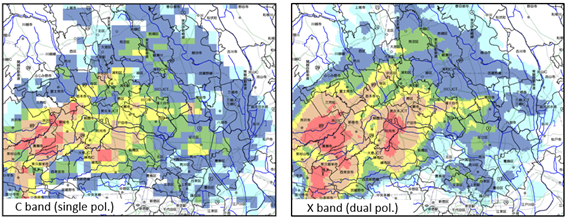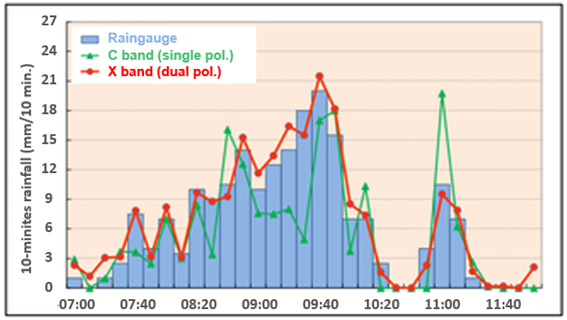Installation and operation of advanced weather radars support
Services
Dual polarization radars effectively monitor rainfall and provide useful information on storms.
Around the world we have seen more and more weather extremes: extreme high and low temperature events, heavy rains, and droughts. Driven by the recent significant advances in observational technologies, Weather radars have been widely used to meet precipitation detection and rainfall and flood prediction needs. Japan Weather Association (JWA) provides a package of radar installation and operation services: radar installation planning, verification of observation accuracy, observational parameter optimization, and monitoring system construction. JWA facilitates customized installation of advanced Weather radars to meet customer’s specific needs and provides expert weather consulting services using the rainfall information from the systems.
Benefits of Dual polarization radars
Weather radars quickly collect meteorological information across an extended area and have technological advantages in observing cumulonimbus clouds and cyclones, the common causes of heavy rains and blasts. In Japan, dual polarization radars equipped with solid-state power amplifiers (SSPAs) have been commonly installed because of the capability of highly accurate precipitation estimation, in addition to many other features.
Weather radars use S-band waves with a wavelength of approximately 10 cm, C-band waves with a wavelength of approximately 5 cm, or X-band with a wavelength of approximately 3 cm. X-band radio waves, which are used for dual polarization radars, cover less of an area than the S- and C-band waves, although the potential for high resolution provides high-precision observation.
Indeed, the XRAIN (eXtended RAdar Information Network), which is operated by the Ministry of Land, Infrastructure, Transport and Tourism, collects detailed rainfall data at approximately 250-m intervals every minute and delivers information useful for evacuation and disaster prevention if a heavy rain occurs.
JWA consulting services
・Radar installation planning
・Verification of observation accuracy
・Parameter optimization
・Construction of monitoring system
・Consulting services on use of rainfall data
・Assistance in replacing an existing single-polarization radar with a dual polarization radar
・Planning of weather observations tailored to customer’s business needs and purposes, as well as composite radar rainfall estimations

Comparison in rainfall distribution between conventional and dual polarization radars

Applications
・Acquisition and utilization of mesh size-specific rainfall data
・Real-time rainfall monitoring and urban flood risk management for buildings during heavy rains
・Use in railway and road monitoring and management activities for safe operation
Glossary
Dual polarization radar: A kind of state-of-the-art rainfall observation radar. The radar transmits two types of radio waves, horizontally and vertically polarized ones, and collects information on different aspects of raindrops. It provides more accurate rainfall observations than conventional (single polarization) radar.
Solid-state power amplifier (SSPA): The amplifier uses narrow-band, low-output and highly stable solid-state devices (semiconductor devices) for transmitting radio waves, unlike conventional electron tubes (e.g., klystrons).
